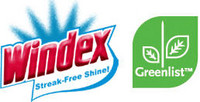Thursday, September 10, 2009, 10:46 AM
Posted by Administrator
Posted by Administrator

OK, this is something we have all witnessed but may not know there is actually a term for it. When we see green labels on items that just don't seem to be green in any reasonable way and wonder, "how does this product help the environment"? This question we ask ourselves is probably a good indicator that something is not right and "greenwashing" may be involved. In some cases, you can be sure "greenwashing" is involved.
The product that first irked me was actually window cleaner. Yes, I still use the product. However, when my bulk supply runs out, I may refill with vinegar and a few grains of water softener. The problem is not so much the product as it is the claim. Take cars for example: Lets face it, cars do nothing to help the environment, more efficient cars just hurt it less, but most of us still depend on them. Because we depend on them, we do the next best thing and try to drive less, use more fuel efficient models and consider the impact before taking action. While this isn't perfect, it does help versus business as usual.
The label on the window cleaner bottle struck me as almost offensive. How could amonia, water and a plastic bottle be eco friendly? I buy the bulk refill to cut the plastic and transport to a minimum, but this is not a product that protects the environment. Note that the "Greenlist" logo makes no claims. This is just a logo that creates a positive image and a name that creates positive thoughts. There is nothing wrong with it. However, the purpose is clear, it creates association of positive environmental impact with the product.
SC Johnson came up with a quasi-certification mark "Greenlist tm" for ranking its own raw materials to help "families quickly identify that SC Johnson products are made with a commitment to a more positive health and environmental profile." This is the certification on the bottle! SC Johnson creates a label that seems to appear like an outside entity and places it on the product to certify the environmental friendliness! Wow.
There are plenty of other companies doing the same kinds of things. Car companies often claim to be green. We need clarification as to what the green claim identifies. There is a really good breakdown of "greenwashing" and examples on the related link below.


 Calendar
Calendar




